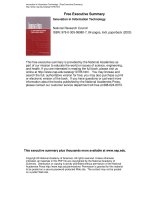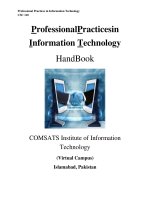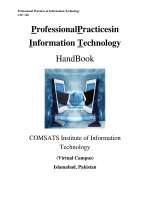Lecture Note Professional practices in information technology - Lecture No. 32: Risk Management (Cont’d)
Bạn đang xem bản rút gọn của tài liệu. Xem và tải ngay bản đầy đủ của tài liệu tại đây (404.51 KB, 6 trang )
Professional Practices in Information Technology
CSC 110
Professional Practices in
Information Technology
HandBook
COMSATS Institute of Information
Technology
(Virtual Campus)
Islamabad, Pakistan
Professional Practices in Information Technology
CSC 110
Lecture 31
Risk Management (Cont’d)
Risk Determination
Example
Asset A has a value of 50 and has one vulnerability, which has a likelihood of 1.0 with no current
controls. Your assumptions and data are 90% accurate
Asset B has a value of 100 and has two vulnerabilities: vulnerability #2 has a likelihood of 0.5
with a current control that addresses 50% of its risk; vulnerability # 3 has a likelihood of 0.1 with
no current controls. Your assumptions and data are 80% accurate
The resulting ranked list of risk ratings for the three vulnerabilities is as follows:
–
Asset A: Vulnerability 1 rated as 55 = (50 × 1.0) – 0% + 10%
–
Asset B: Vulnerability 2 rated as 35 = (100 × 0.5) – 50% + 20%
–
Asset B: Vulnerability 3 rated as 12 = (100 × 0.1) – 0 % + 20%
Likelihood and Consequences
Likelihood and consequence rating
–
Another approach
–
From the Australian and New Zealand Risk Management Standard 4360i
–
Uses qualitative methods of determining risk based on a threat’s probability of occurrence
and expected results of a successful attack
–
Consequences (or impact assessment) are evaluated on 5 levels ranging from insignificant
(level 1) to catastrophic (level 5), as assessed by the organization
–
Qualitative likelihood assessments levels are represented by values ranging from A (almost
certain) to E (rare), as determined by the organization
Professional Practices in Information Technology
CSC 110
Identify Possible Controls
For each threat and its associated vulnerabilities that have residual risk, create a preliminary list
of control ideas. Three general categories of controls exist:
–
Policies
–
Programs
–
Technical controls
Figure 32.5: Likelihood and Consequences 1
Figure 32.6: Likelihood and Consequences 2
Consequences and likelihoods are combined
–
Enabling the organization to determine which threats represent the greatest danger to the
organization’s information assets
The resulting rankings can then be inserted into the TVA tables for use in risk assessment
Professional Practices in Information Technology
CSC 110
Figure 32.7: Likelihood and Consequences 3
Documenting the Results of Risk Assessment
Goals of the risk management process
–
To identify information assets and their vulnerabilities
–
To rank them according to the need for protection
In preparing this list, a wealth of factual information about the assets and the threats they face is
collected. Information about the controls that are already in place is also collected. The final
summarized document is the ranked vulnerability risk worksheet.
Professional Practices in Information Technology
CSC 110
Figure 32.8: Documenting the Results of Risk Assessment 1
What should the documentation package look like?
What are the deliverables from this stage of the risk management project?
The risk identification process should designate what function the reports serve, who is
responsible for preparing them, and who reviews them.
Figure 32.9: Documenting the Results of Risk Assessment 2
–
Professional Practices in Information Technology
CSC 110









